Sharing our rehabilitation stories
Based at Fiona Stanley Hospital, the State Rehabilitation Service provides statewide specialty rehabilitation services for patients following either:
- traumatic or non-traumatic injury to their brain or spine
- amputations
- significant acute illness or trauma.
Often these patients spend extended periods recovering and rehabilitating on the ward.
In December 2022, staff and patients came together to create the ‘Wall of Hope’ showcasing the personal, touching stories and experiences of our acquired brain injury (ABI) patients. This concept has now been adopted across other wards across the service.
Displayed on ward walls, these stories share patient's heartfelt journeys with the aim of inspiring hope amongst all those that read them.
We hope you enjoy reading them below.
In July 2019, my wife Chris and I were riding a motorcycle through Africa for the second time. We were in northern Malawi about to cross into Tanzania on a long narrow, one way bridge. A car stopped on the other end of the bridge and waved us on, but part way across another car came sideways onto the bridge and kept accelerating until they crashed into us at high speed. I braked hard but knew when I hit the ground my back was broken.
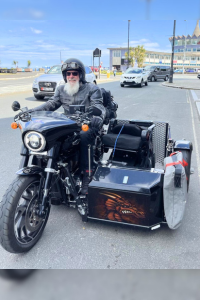 With no ambulances or drugs, it was a long painful drive on the back of a truck to a hospital in Mazuzu, Malawi, before being transferred to Johannesburg Trauma Ward. After five hours on the truck, my wife died from her injuries. It was another hour to the hospital.
With no ambulances or drugs, it was a long painful drive on the back of a truck to a hospital in Mazuzu, Malawi, before being transferred to Johannesburg Trauma Ward. After five hours on the truck, my wife died from her injuries. It was another hour to the hospital.
Chris and I were married for 47 years. Chris was a nurse, and I was a printer by trade. We had the best relationship– she was my soul mate, my best friend. We had children and grandchildren. We travelled with our daughters and did lots of four-wheel drive trips into the bush. I always had motorcycles and my wife rode as well. We loved to travel and for nearly 30 years we rode all over Australia and New Zealand before riding through Asia, Africa and Europe.
I was in three hospitals before finally being transferred to Fiona Stanley Hospital where I stayed for over four months. The rehab process was excellent, and I enjoyed working with the physios and occupational therapists.
I enjoyed the company of others as we encouraged each other to keep pushing, and I’ve made lifelong friends. Their encouragement spurred me on and gave me the strength to be able to live life independently in Albany as a paraplegic in a wheelchair.
This is a different life compared to my life before the crash in many ways. I’m proud of being able to speak in public about people with disabilities and the struggle that can entail. I have worked with the Albany City Council to improve accessibility, written songs to help me cope, played with WA musicians in pubs and larger venues and had a fantastic friend/engineer who modified my four-wheel drive and motorcycles so I can use them as a paraplegic. A highlight was a four-month ride on my Harley Davidson outfit through the UK, and parts of Europe last year.
- Bob
In January 2023, when I was 19 and a reckless teenager, I fell off a three-storey balcony. Unconscious and having lost a lot of blood, I was rushed to Rockingham General Hospital for a blood transfusion.
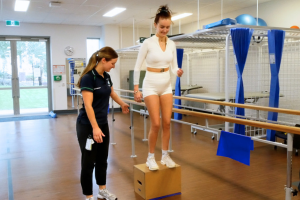
For three weeks, I was in a coma in the Intensive Care Unit (ICU) at Royal Perth Hospital. I had a fracture at the base of my skull, blood clots on the brain, a shattered pelvis, multiple bone breaks from neck to waist, a punctured lung, kidney bleeds and many other complications.
Due to the pressure on my brain, I had a stroke and bone had to be surgically removed from the back of my head to relieve the pressure. I then needed an EV drain in my head to drain the fluid that was building.
I also needed a tracheostomy to give me airways, so for four months I couldn’t eat, drink or talk. Due to more complications, I also couldn’t hold food down through a nasal feeding tube, so had to be fed via an IV with a TPN bag to get some nutrients to survive. I also couldn’t use my bowels from laying in bed for such a long period of time.
After having four EV drains and subsequent infections, I had surgery to have a VP shunt put in my head. Unfortunately, I then got pneumonia and nearly ended up back in ICU after four months.
Despite all these issues, I made it through with my family – they were by my side every single day.
I was then ready to have the tracheostomy taken out, but it had grown skin which was blocking my airway and I needed more surgery. After this I was able to start learning to talk and chew food for first time in five months.
My walking and balance skills were the hardest to build up, but I never gave up and pushed through.
After a seven-month hospital stay, including a short stay at the Fiona Stanley Hospital (FSH) State Rehabilitation Service for rehabilitation, I made it home and my mum became my full-time career.
My mental health was terrible and I worked hard to manage issues including depression, impulsivity, and moods. I still work to manage these every day.
I’m coming to terms with having to learn to drive again, and that my whole world has changed for a 21-year-old, for the better now!
My goals are starting to take place with my independence and getting to places without my mum, so I’m giving back to the community by volunteering at FSH to have a sense of purpose again.
Before the accident I was an aged care worker – I absolutely loved it and was good at what I did. I miss my job more than anything, and my ultimate goal is to get back to it.
I also talk to youth about my experiences and the impact drugs and alcohol can have on our families and friends. I hope my story reaches a few teenagers to stop them from doing what I did and this happening to them.
- Gracie
Prior to my injury I was what they call a jack of all trades but master of none. I had my own business that covered anything and everything, from building sheds to fencing.
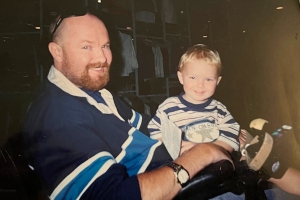
In August of 1999 I was driving home late one night. I had spent a lifetime driving home late and not sleeping and so I was fatigued and tired at the wheel. I was about five kilometres from home at 4am when I hit a tree and suffered a number of vertebral fractures to C6 and C7. I remember seeing a triangle of blue sky through a gap in my car before going unconscious and unaware to the events that followed.
Unfortunately on the way to the hospital, we hit a bump on the road that resulted in the fractures cutting through my cord. I woke up with a tracheostomy to support my airway and spent five weeks in the intense care unit at Royal Perth Hospital. Eventually the tracheostomy was removed and I started rehabilitation at Shenton Park.
I had a rocky start to my rehabilitation due to pain, it became my personality and I was angry. It kept me up at night and there was nothing I could do about it. When the pain finally subsided, and it did, I found myself having good experiences. We celebrated birthdays and the nurses organised barbecues and even spent one Christmas in hospital.
Since my initial admission I have spent time in Shenton Park and at the State Rehabilitation Service at Fiona Stanley Hospital. Initially I didn't realise the new and different ways I had to use my body, and had to constantly fight with my mind due to my previous strong desire for independence. Losing this and having to relearn everything was a shock to the system. If it hadn't been for the intensity of the occupational therapists and physiotherapists who helped me to learn the basics – like picking things up and sitting upright – I would not have been prepared to sit up in my chair, face life and continue to the next step of my journey.
Life now is different, but I continue to put a smile on my face and go out and face everything life throws at me. I have worked closely with the Paraplegic Benefit Fund (PBF) over the years, delivering spinal cord injury prevention talks, and am currently in the process of starting my own business. The focus will be on delivering talks and education on spinal cord injuries and prevention, and exploring everything from lived experiences, mental health, to speaking with nurses and carers and educating them on what to expect and how to help patients as they deal with their emotions.
I know what it's like to be an angry and frustrated patient who is struggling to come to terms with what has happened, so I hope to help enlighten others on what may be going through our minds.
- Gregory
Before becoming a wheelie, I lived on a farm with my husband Ric in Margaret River. It was our escape from the city. I walked every day, gardened regularly and had a wonderful job. Unfortunately, Ric had cancer, so time was precious, and we were in the process of moving to Busselton.
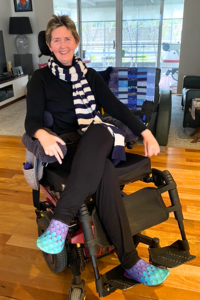 I sustained my injury driving home from work in August 2021 when a tree fell on my car. I don't recall much from the accident, but woke up in intensive care unit at Royal Perth Hospital following three operations, with a tracheostomy and nasogastric tube for six weeks and a plate in my neck.
I sustained my injury driving home from work in August 2021 when a tree fell on my car. I don't recall much from the accident, but woke up in intensive care unit at Royal Perth Hospital following three operations, with a tracheostomy and nasogastric tube for six weeks and a plate in my neck.
I learned I was paralysed from the diaphragm down with what is referred to as an incomplete quadriplegic. I could not talk or hear properly, so communication was limited to eye movements and nodding.
I was fortunate to be transferred to the State Rehabilitation Service (SRS) at Fiona Stanley Hospital for rehabilitation. The nurses welcomed me and outlined a detailed plan for recovery. Having goals to work towards kicked my brain into go mode. All the amazing staff gave me lots of education and helped me to cope. I needed to learn that tiny movements were actually huge achievements in my recovery. Everyone celebrated each small step forward, as if I had won an Olympic medal. I started to feel a rise in my energy and spirit. My family and friends were integral to my recovery, visiting me often, making colourful blankets for my bed and cakes for the staff. They also brought me clothes I could get into to look good again and helped with stretching.
We packed a lot into the four months I was at the SRS. Attending physiotherapy and occupational therapy, with assistance from rehabilitation engineering, helped improve my strength and fine motor skills. This enabled me to be in a wheelchair in the outside world and communicate with family in hospital. Ric and I could now talk daily, which was precious. I felt like I had freedom at last.
The hospital staff soon rushed me home as Ric was palliative and I was desperate to spend some time with him. Ric had been so very strong and achieved his goal of preparing the house for a wheelchair and seeing me home. Unfortunately, we only had one night home together.
Once home, I kept busy and participated in the disabled surfing day, my best day since having a spinal cord injury. The joy of riding a wave with so many happy volunteers alongside to catch me lifted my spirits.
Since leaving the SRS, I have enjoyed wheeling around saying hello to the fantastic staff – they gave me so much. I am not back at work yet, but am able to join in community events, go swimming and snorkelling. My current goal is to get fit enough to travel to Melbourne to see family.
To anyone who reads this, I wish you well on your new journey. Open your heart to receive the positive energy the rehabilitation staff exude, celebrate small steps, laugh at yourself every day, and the road forward will smooth out.
- Kerry
On a Friday night after work I 2016, I was riding a BMX bike around a car park with some mates. I was bunny-hopping over a milk crate, and someone decided to place a wheelie bin on its side, which was a little taller and wider than the milk crate.
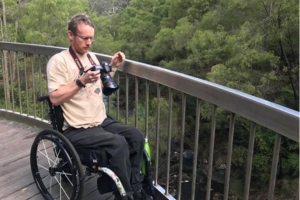
Drinking with my mates, it seemed like making the jump was within my capacity, however I misjudged and when I was in the air, the back wheel of the bike hit the bin and threw me over the handle bars. I landed on my head, collapsed around the thoracic area and broke two vertebrae which left me a complete paraplegic from about T6.
I lived a very active and busy life, working in civil construction for 15 years prior to my accident. I have been lucky to since achieve a lot including riding the Gibb River Road for a charity event in a team to raise funds for Royal Flying Doctor Service. I spent a lot of my time working on my own projects, camping, fishing and doing plenty of handyman tasks or jobs.
My first time on the spinal ward was for three months in late 2016 as I learnt how to live with a spinal cord injury. I gained a lot of strength and mental stamina through what I learnt from physiotherapists, and even more confidence was built through the relationship of the peer support people from the Paraplegic Benefit Fund I was lucky to chat to on a weekly basis.
My life post-injury was initially a little up and down, with some more down times over gaining strength to get back to somewhat of a normal lifestyle. I had some complications that required more surgery which meant more time spent on the Spinal Ward. I was able to bounce back to a happier place after this and continue moving on while living with a spinal cord injury.
In 2019, three and a half years after my initial diagnosis, I was given the all clear from my neurosurgeon to start working again and get out and about more. I've been lucky to be involved in para-golf, adaptive mountain biking, abseiling down the QV1 building (twice!), fishing, interstate travel, seeing the Great Barrier Reef, go karting and playing State League basketball, all while back to working full time hours.
- Clint
So, a little bit about myself. I lived and worked in Broome as an enrolled nurse whilst studying a Bachelor of Nursing before my injury. Living up in Broome for 12 years
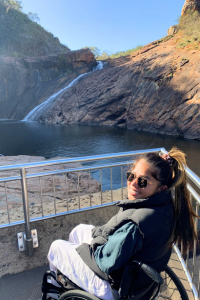 turned me into a bit of an outdoor adventurer – you would catch me at the beach most afternoons watching sunsets with friends and a few cold ones in hand. The weekends were spent fishing, boating, crabbing or camping somewhere in the Kimberley. I have since moved down to Perth but still dream about Broome time and hope to make it up there again one day.
turned me into a bit of an outdoor adventurer – you would catch me at the beach most afternoons watching sunsets with friends and a few cold ones in hand. The weekends were spent fishing, boating, crabbing or camping somewhere in the Kimberley. I have since moved down to Perth but still dream about Broome time and hope to make it up there again one day.
On 14 November 2021, I dove into shallow water in a swimming pool and broke my C5 vertebrae. Following this I spent six months at the State Rehabilitation Service on the State Spinal Unit. I met so many incredible people, including assistants in nursing, nurses, occupational therapists and physiotherapists. They all wanted to help me reach my goals and understood that some days just getting out of bed and putting a smile on my face was harder than others.
Rehabilitation was challenging at first as I adjusted to the varying bladder, bowel and blood pressure issues and frequent occasion of feeling like I was passing out. By the time I was discharged from the spinal unit I had relearned how to feed myself, slide board transfer and cook with assistive aids.
Life post-rehabilitation and living with a spinal cord injury hasn't been easy, but it does get better. I started the process of getting back to work with EmployAbility who help people living with a spinal cord injury get back into the workforce. I am also able to sit for a driving assessment which is a great source of excitement.
My partner and I purchased our first home in Perth and I graduated from university with an excellent student award. We have travelled to Thailand, Tasmania and Brisbane and continue to plan more holidays including Japan for my birthday.
- Stung
On 22 October 2022, I was working on my roof at home. Despite not quite remembering the fall, I learned it was a dive, falling three metres onto my head and shoulder.
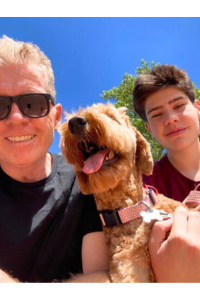
My daughter found me 10 minutes after the fall had happened and called an ambulance. For seven weeks I was in and out of a coma, and at the end of the seven weeks, I awoke. All my memory of the accident and the period during the coma was gone, and my request to be moved to Fiona Stanley Hospital State Rehabilitation Service (SRS) was met at week 10.
Everything started getting better from day one at the SRS. I was amazed at the incredible staff who nurtured me to much better health in just seven weeks. There were so many wonderful staff and their concern and total effort with me was incredible.
After seven weeks I returned home with a complete follow-up plan to improve my health and to bring me back to a far better place that I once was. I am completely blown away by their professional efforts and personal kindness to have come back from a such a bad place. My advice is to engage with the staff as often as you can to improve your health and excitement in returning to normal life.
I will mention that two stand out performers were staff members Michelle N and Elysha B who were extremely supportive and encouraging. I thank you both, with my deepest heart, for my return home and the efforts that you made along my journey.
- Nick
In October 2017 I had a motorbike accident. I don't have my memory from the moment, but it appears I lost consciousness whilst riding and missed turning a simple corner. I went straight through and off a bridge, landing on the bank on the other side before rolling into water. My friend who was riding ahead of me saved my life and called an ambulance.
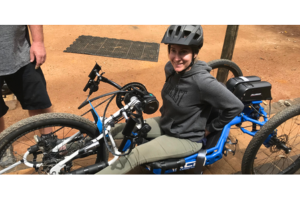
Before my injury, I was super active, going out with friends, riding my motorbike, camping, playing volleyball and doing all the crazy things young people do. I was passionate about photography and started growing a little side business.
I was in Royal Perth Hospital for roughly two months before being transferred to Fiona Stanley Hospital State Rehabilitation Service for rehabilitation for roughly four more months. I had to start again and learn how to sit up without throwing up, to dress myself, to use the toilet and shower. My determination and willpower helped, but it didn't override the depression and the phenomenal amount of bad days I experienced.
I bonded with some of the staff on the ward and the became like family to me. I secretly didn't want to go home because I feared letting go of that nurse button. The true rehabilitation begins when you get home and try to piece your life back together. I cannot stress the importance of talking to people going through a similar experience. Those bonds will last a lifetime.
My experience and journey back to independence took about four years. I had so many bladder and bowel issues that I hardly left the house for one of those years. With the help of my friends, I grew more confident with my presence in the community and my ability to do things I never thought I'd do again. I started a list of ‘firsts’ since being in a wheelchair. From the first time I went to the toilet on my own, to the first time I jumped out of a plane skydiving over Rottnest. Watching that list grow brought me back to engaging with life.
I now live independently in my modified home and work part time at the Paraplegic Benefit Fund. Before I went back to work, I had to find something that made life worth it. I found a love for mountain biking, camping and going to live music events with my friends. I also got myself a drone to keep my photography passion alive.
- Ebony
On 4 September 2022 (Father's Day) I was sitting in my lounge chair and noticed my legs starting to feel prickly, with the sensation starting at my feet and slowly moving upwards.
I was admitted to Joondalup Hospital and while the doctors worked hard to find the source of my symptoms, something attacked my bowel. I underwent emergency surgery to remove a section of my bowel, which saved my life. 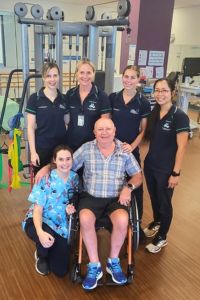
After spending a week on a ventilator, doctors discovered I had transvers myelitis. Consequently, I suffered paraplegia. After spending seven weeks in Joondalup Hospital, I was transferred to the spinal ward at Fiona Stanley Hospital State Rehabilitation Service (SRS).
Prior to my hospital admission I was a very active person. Although retired, I was still actively involved with many hobbies including helping a mate on his farm, working two days a week mending and maintaining farming machinery.
Despite spending five and a half months in hospital, I rarely let it get me down and worked very hard on my rehabilitation to improve as quickly as possible.
The doctors and nurses were particularly wonderful, doing as much as they possibly could to help me improve and get me ready for my early gym sessions every day. The physiotherapists in the gym were an absolute treat to work with, and their attitude and expertise made it a pleasure to go to the gym. I constantly improved with every session and always looked forward to my time there every day.
Since being discharged I have steadily improved. When I arrived at the SRS I was being transferred to my bed using a hoist attached to the ceiling. I can now walk at home with the aid of a frame or walking sticks. I even ride an e-Tricycle!
After leaving hospital I trained for and participated in a cancer fundraiser ride organised by Harry Perkins Institute for Medical Research. Over the two-day, 110-kilometre ride from Perth to Mandurah, I raised over $10,000 whilst being an ambassador for the ride. I was also asked to share my story on stage to 1,500 people at one of the celebrations, and I received a standing ovation.
- Kym
On 11 September 2021, at the age of 56, I suffered a ruptured basilar tip aneurysm.
I spent many weeks at Sir Charles Gardiner Hospital due to complications. I was in an induced coma for four weeks, developed fluid on the brain, and had two brain infections. This resulted in two surgeries being performed to save my life.
I have no memory of my time in hospital, but I have been told I spoke in different languages and thought I was 23 years old. 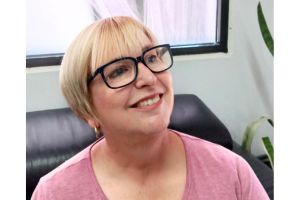
I developed an acquired brain injury and was transferred to Fiona Stanley Hospital State Rehabilitation Service in October 2021.
The amazing nursing assistants, nurses, therapists and doctors supported me in my gradual recovery. I attended speech therapy with Kate to improve my comprehension and word retrieval. I was in a wheelchair, so a lot of hard work occurred in physiotherapy with Gia in the gym and hydrotherapy pool to help me develop balance, strength, coordination and to learn to walk again.
I attended occupational therapy sessions with Danielle which helped with life skills and memory strategies. I cooked many wonderful breakfasts at breakfast club with the support of allied health professionals.
The hard work began when I was discharged. I was part of a brain study at The University of Western Australia and worked hard to improve my deficits by attending outpatient therapy sessions at Rockingham General Hospital, Fiona Stanley Hospital and the Curtin University Clinic.
I have become a volunteer on SRS Ward B and am gradually returning to work as a primary school special needs teacher with the help of the State Head Injury Unit.
- Kate
Back in March 2021 I was supporting my friends at a beach volleyball competition. We were mucking around and decided to go for a swim at the beach. I thought I was in the deep part of the water, however I hit my head on a sand bank.
My friends helped me out of the water and pulled me to shore, and luckily there were a few doctors in the volleyball competition there to help. 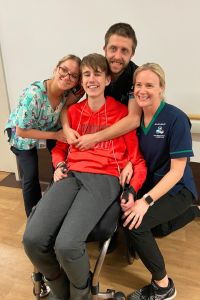
As they were unable to get an ambulance onto the beach, I ended up having to take a helicopter to Royal Perth Hospital (RPH). I struggled to get into the helicopter as I was too tall, went in and out of consciousness, and even vomited on the ambulance staff.
I stayed on the Intensive Care Unit at RPH for 16 days, undergoing a whole bunch of tests and finding out I had experienced a C6 spinal cord injury, before transferring to the spinal ward at Fiona Stanley Hospital State Rehabilitation Service (SRS).
At the time of my injury, I was completing Year 10 at high school and was heavily involved in volleyball, training with the state team. I had aspirations to compete in volleyball at a high level with the hope of it becoming my future career.
When I was transferred to the SRS, I felt really weird and out of place adjusting to a new environment and the unexpected. Anne, the Nurse Unit Manager at the time, used to come in and help me with breakfast.
I had regular visits from friends, my consultant was incredible, and my assigned nursing keyworker helped me to adjust to my new life on Ward 1A. I continued my studies every morning I was there, attending the school on the level above Ward 1A, and the teachers were amazing and so supportive.
I was always in the gym with the physiotherapists at any chance I could get. In the eight months I was there, I got to know and meet a bunch of amazing people that showed up to their job day in and day out, even during the tough times, and that is something I am so grateful for.
My biggest achievement, and what I am most proud of, is graduating Year 12 after my accident. After graduating, I went to university to complete a media creations degree.
I continued with my passion of volleyball whilst in Year 12 through coaching the junior years, and have continued to keep up with my physiotherapist following my time on the spinal ward.
Since being home, I have found it can be difficult – it is limiting every day – but I keep talking to people, keep active, and keep my mind occupied to help me move forward.
- Lawson

